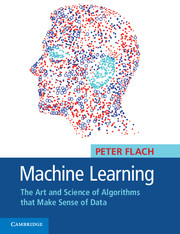Book contents
- Frontmatter
- Contents
- Preface
- Prologue: A machine learning sampler
- 1 The ingredients of machine learning
- 2 Binary classification and related tasks
- 3 Beyond binary classification
- 4 Concept learning
- 5 Tree models
- 6 Rule models
- 7 Linear models
- 8 Distance-based models
- 9 Probabilistic models
- 10 Features
- 11 Model ensembles
- 12 Machine learning experiments
- Epilogue: Where to go from here
- Important points to remember
- References
- Index
12 - Machine learning experiments
Published online by Cambridge University Press: 05 November 2012
- Frontmatter
- Contents
- Preface
- Prologue: A machine learning sampler
- 1 The ingredients of machine learning
- 2 Binary classification and related tasks
- 3 Beyond binary classification
- 4 Concept learning
- 5 Tree models
- 6 Rule models
- 7 Linear models
- 8 Distance-based models
- 9 Probabilistic models
- 10 Features
- 11 Model ensembles
- 12 Machine learning experiments
- Epilogue: Where to go from here
- Important points to remember
- References
- Index
Summary
MACHING LEARNING IS a practical subject as much as a computational one. While we may be able to prove that a particular learning algorithm converges to the theoretically optimal model under certain assumptions, we need actual data to investigate, e.g., the extent to which those assumptions are actually satisfied in the domain under consideration, or whether convergence happens quickly enough to be of practical use. We thus evaluate or run particular models or learning algorithms on one or more data sets, obtain a number of measurements and use these to answer particular questions we might be interested in. This broadly characterises what is known as machine learning experiments.
In the natural sciences, an experiment can be seen as a question to nature about a scientific theory. For example, Arthur Eddington's famous 1919 experiment to verify Einstein's theory of general relativity asked the question: Are rays of light bent by gravitational fields produced by large celestial objects such as the Sun? To answer this question, the perceived position of stars was recorded under several conditions including a total solar eclipse. Eddington was able to show that these measurements indeed differed to an extent unexplained by Newtonian physics but consistent with general relativity.
While you don't have to travel to the island of Príncipe to perform machine learning experiments, they bear some similarity to experiments in physics in that machine learning experiments pose questions about models that we try to answer by means of measurements on data.
- Type
- Chapter
- Information
- Machine LearningThe Art and Science of Algorithms that Make Sense of Data, pp. 343 - 359Publisher: Cambridge University PressPrint publication year: 2012



